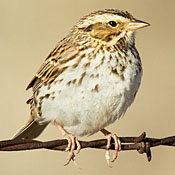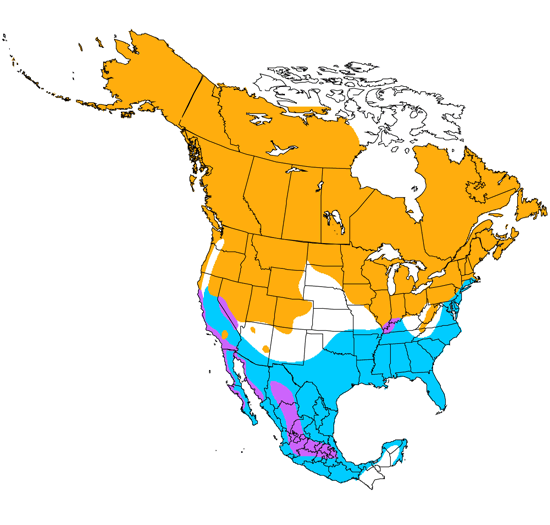Savannah Sparrow
Passerculus sandwichensis

Perching

Length: 6 in. (14 cm )
Almost entirely limited to grassy meadows, marsh edges, and prairie areas, this sparrow is most easily seen perching on a tall grass or on a barbed wire fence. The grassy nest is concealed on the ground usually under overhanging grasses. During the summer, spiders and insects are added to the seed diet. In the winter, the Savannah Sparrow often occurs together with several other species of sparrows in scattered flocks in grassy areas. Populations breeding in different parts of the continent have varying amounts of yellow over the eye, and the bill size is much larger in some populations than others. In the winter many of these different appearing populations flock together in a confusing array.
The four-digit banding code is SAVS.
Bibliographic details:
- Article: Savannah Sparrow
- Author(s): Dr. Biology
- Publisher: Arizona State University School of Life Sciences Ask A Biologist
- Site name: ASU - Ask A Biologist
- Date published: 13 Jul, 2017
- Date accessed: 21 May, 2025
- Link: https://askabiologist.asu.edu/activities/bird/savannah-sparrow
APA Style
Dr. Biology. (Thu, 07/13/2017 - 15:37). Savannah Sparrow. ASU - Ask A Biologist. Retrieved from https://askabiologist.asu.edu/activities/bird/savannah-sparrow
Chicago Manual of Style
Dr. Biology. "Savannah Sparrow". ASU - Ask A Biologist. 13 Jul 2017. https://askabiologist.asu.edu/activities/bird/savannah-sparrow
MLA 2017 Style
Dr. Biology. "Savannah Sparrow". ASU - Ask A Biologist. 13 Jul 2017. ASU - Ask A Biologist, Web. https://askabiologist.asu.edu/activities/bird/savannah-sparrow
Be Part of
Ask A Biologist
By volunteering, or simply sending us feedback on the site. Scientists, teachers, writers, illustrators, and translators are all important to the program. If you are interested in helping with the website we have a Volunteers page to get the process started.








